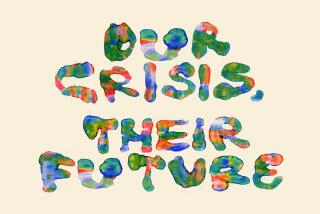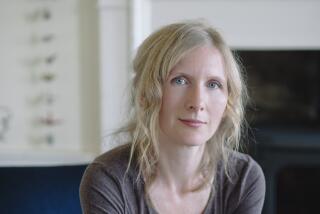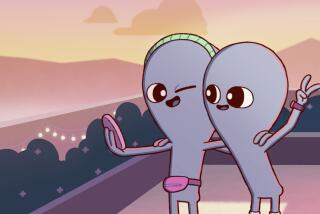Anti-gravity solar system
- Share via
READING Dava Sobel’s “The Planets,” I thought for a moment that I know what makes a writer a journalist: Journalists are stylists. They are more interested in how they present a subject than in the subject, or else they don’t trust that subject to interest a reader unless they approach it in an arresting, startling or mannered way. Ernest Hemingway was a great journalist. So, perhaps, was Gertrude Stein.
Sobel is a very good journalist, as the success of her book “Longitude” would testify. It may be unjust to imply that she’s less interested in what she writes about than in the way she writes about it. Her declarations of fascination with the solar system, the “planet fetish” she’s had since the age of 8, are surely sincere. Yet this appears not to have been the kind of straightforward interest that leads a kid to read everything she can find about the planets and dream of being an astronomer; rather, it seems a playful fancy, decorated with diverting similes and full of human interest.
“Earth,” she writes, “had siblings in space, just as I had older brothers in high school and college.” As a consequence, Sobel’s inquiry into the planets, though full of solid information from reliable sources, constantly swerves and bobs about for tidbits, eye catchers and clever narrative devices. One chapter is presented as if written by the planet Mars, another from the point of view of Caroline Herschel, the 96-year-old sister and assistant of the man who discovered Uranus. Such fictionalizing tricks are entertaining enough, although the material really doesn’t need them.
In one spot, however, they lead the author off track altogether. Some consideration of astrology is quite appropriate to a book about the planets and their significance to humanity, but Sobel’s chapter on Jupiter seems to endorse astrology rather than merely discuss it. Of Jupiter’s Galilean moons, Sobel writes, “Just as the planetary alignments in a horoscope limn the possibilities of a life, so the relative positions of these moons have determined their destiny.” Then she spends two paragraphs describing an astrological chart drawn up for the spacecraft Galileo and the accuracy of its predictions.
Though Galileo Galilei, like most people of his time, believed in astrology, it’s not his beliefs for which we honor him but his science, the laborious honesty of his observations and hypotheses. To put astrology on the same footing as astronomy is to concede the claim of “intelligent design” proponents that baseless assertions, wishful thinking and dogmatic systems somehow deserve equal time with scientific observation. Galileo knew better. Required on pain of death to deny the observational knowledge that the Earth moves and restate the dogmatic belief that the Earth does not move, he did so, but (the story goes) under his breath he muttered, “All the same, it moves.”
It moves; everything moves; science itself moves almost as majestically and rapidly as the planets. The histories and discoveries Sobel relates need no ornament; they’re stunning in themselves. Her language in relating them is often fittingly vivid, eloquent and plain: “At the center of the Earth, part of the iron nickel core has already cooled to a solid ball. Seismologists can hear it rotating independently inside the still molten outer core, turning almost one second a day faster than the rest of the world.” Wow! I wish I’d known that when I was 12! I’m glad I know it now, and only wish there were more about that ball bearing whirling inside the world. I want to know how the seismologists hear it and what they hear.
“The Planets” is very short for its vast subject, especially since it comes at the solar system simultaneously from several directions: descriptive, mythological, historical, anecdotal, biographical and aesthetic. Such a compendium in only 231 pages, with a small appendix of “Details,” leads Sobel to write at breakneck speed, hitting high spots and leaving out a lot in between. It is a pace designed, perhaps, for those who run while they read. The chapter about Earth contains a whirlwind 18-page trip through the voyages of Columbus, Balboa, Magellan, Halley, Cook and Darwin, all in the gasping present tense of the sports reporter. I got so dizzy I was glad to stop trembling a bit at Darwin’s earthquake in Valdivia.
There’s a great deal of good data and fascinating information in this chapter and in the book as a whole. Yet it comes so fast and from so many directions, and the selection of subjects seems so often almost random, that I begin to wonder who “The Planets” was written for. Though quite accessible to a good reader of 10 or 12, the book is not for kids in most American schools because they lack the necessary background context into which to fit the scattershot names, dates and data. It’s for adults, then, but which adults? Those with some memory of school or college history or general science courses, I guess, who are happy to be reminded of such matters and to learn some new facts and connections without having to go very far into anything or think very hard about it. This is the solar system lite.
I’m not trying to be snarky about it. There are times you want stout and times you want lite. Each planet came together and organized itself out of a whirling mess of dust and pebbles and ice chunks and cosmic sweepings and debris; and in the same way Sobel, acting as the force of gravity, has pulled together a piecemeal mess of disparate bits of information and made a more or less whole thing. It isn’t a rock planet, or a gas giant, but it is a pleasant, undemanding, often tantalizing, sometimes exciting book. *
*
From The Planets
WHATEVER daily concerns dominate our minds at the dawn of the present century, the ongoing discovery of extra-solar planetary systems defines our moment in history. And our own Solar System, rather than shrink in importance as one among many, proves the template for comprehending a plethora of other worlds.
Even as the planets reveal themselves to scientific investigation, and repeat themselves across the universe, they retain the emotional weight of their long influence on our lives, and all that they have ever signified in Earth’s skies. Gods of old, and demons, too, they were once -- they still are -- the sources of an inspiring light, the wanderers of night, the far horizon of the landscape of home.
More to Read
Sign up for our Book Club newsletter
Get the latest news, events and more from the Los Angeles Times Book Club, and help us get L.A. reading and talking.
You may occasionally receive promotional content from the Los Angeles Times.








